Sales coaching 101: How to empower and uplevel a hybrid team

For many sales leaders, most of their time is spent on “high-value” tasks. How much of that involves sales coaching?
That probably depends on your org structure, the number of team members you have, and other variables.
Often though, sales coaching is one of those things that get neglected or pushed to the side in favor of closing—especially when month-end (and/or quarter-end) rolls around.
But it’s an essential step to leveling up your team and hitting ever-increasing targets. So, how can you make sure you’re giving your sales reps what they need to perform consistently at the highest level possible while juggling other responsibilities and deadlines?
I’ll walk you through a few tips and our sales org does coaching—at scale—at Dialpad.
But first, let’s define what we mean by “sales coaching.”
What is sales coaching?
Sales coaching is essentially how you teach your sales team to continuously improve and hit their targets. (Cue that “Coffee is for closers” scene.) It’s a blend of skills-based training, technology-based training, incentives, and good old support and encouragement—and the proportions of this blend changes depending on each sales rep receiving this coaching.
Obviously, sales managers all have different styles, but ideally, every sales organization will have some type of established system here for consistency. One important thing to note is that sales training shouldn’t just happen during onboarding—in my experience, the most successful sales coaching happens regularly, over the long term. Unless your sales reps have photographic memories or are incredibly fast learners, they’ll need that constant reinforcement for some time before you can fully take the training wheels off.
The benefits of sales coaching done right
More closed deals
Good sales coaching enhances your sales reps' skills, which is great—but ultimately, it helps them book more meetings and close deals more effectively, meet or exceed targets, and drive revenue growth.
Longer-term customer relationships
A truly well-coached sales team isn't just focused on closing deals. Yes, they tend to be good at that, but they also have a longer-term view—will this customer's LTV (Life-Time Value) extend beyond just this month or this year? Will I be able to help them grow into our product or service, and then upsell them down the road?
Done right, sales coaching helps sellers get into this more customer-centric mindset, which leads to improved customer satisfaction, loyalty, and stronger relationships.
Enhanced employee engagement
Beyond all the metrics and numbers, a strong coaching culture fosters employee growth, engagement, and retention by demonstrating a commitment to their development and success. Sales orgs are known for high employee turnover. It's very common for reps to get burned out by the sales process or the quotas they have to hit, and they leave. But the cost, both in time and in money, of training and ramping new reps is significant. It doesn't make good business sense to spend all that time ramping up new hires only to let them disengage and feel like they have to leave just a year or two after joining your company.
This is an underrated, but important, consideration that a good sales coaching strategy should address.
Overall sales coaching techniques and approaches
Live on sales calls
There are a few ways you can do sales coaching. First, there’s coaching on sales calls. This is when you’re giving a sales rep tips while they’re on a live call with a prospect. It’s more of an in-the-moment approach, and can get pretty time-consuming and draining when you’re personally coaching every call, one rep after another.
One interesting thing Dialpad can do is transcribe calls in real time. But not only that, it can also do live sentiment analysis, which means sales managers can quickly see if any calls are going south and need their help.
If so, they can open up the transcript, which is updated as the conversation is happening, to get more context before deciding whether they need to jump in to help a sales rep:
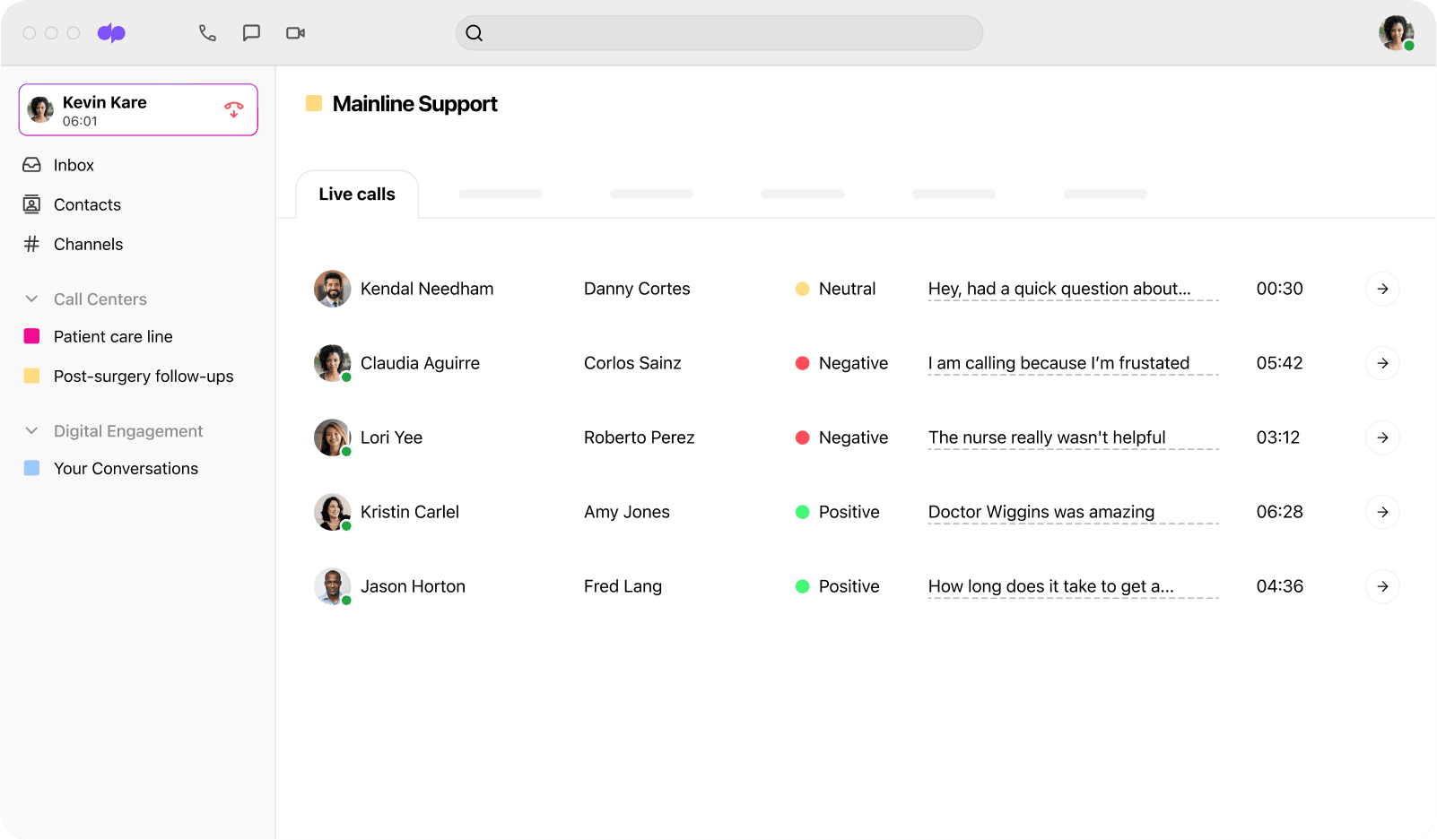
Automated sales coaching
This is a great complement to live on-call training. If your sales managers oversee large teams, it’s not always realistic to expect them to sit in on every call and give your sales reps tips.
So, we use Real-time Assist (RTA) cards, which are an AI-powered feature in Dialpad. These are great because they’re essentially cheat sheets with tailored notes on different topics—and I can set them to automatically pop up on my sales team’s screens when those topics come up on sales calls. We can even set them to pop up when the customer says the keyword, or when the agent says the keyword, or when either party does!
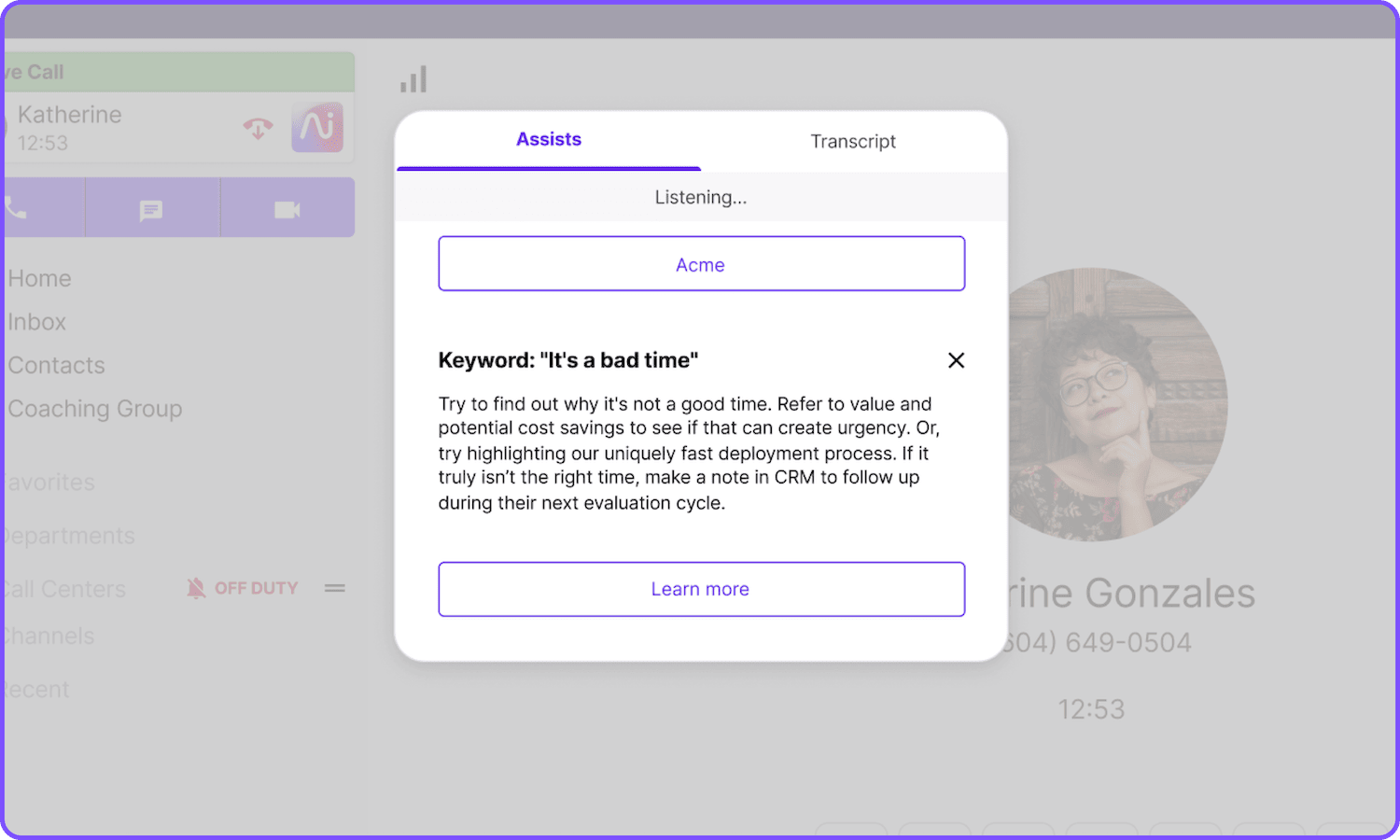
For example, I can create an RTA card for “Competitor X” with notes on how we should position our products against them, and set that to trigger if a prospect brings up Competitor X’s name. I can do the same for any other objections that come up (pricing, a certain feature, and so on).
This way, our sales leaders don’t have to personally help on every call when tricky questions come up, but our sales reps can still get the information and answers they need to move deals forward on calls.
It’s essentially sales training—on a massive scale. (Plus it’s super useful when we’re onboarding new hires and want to help them ramp up quickly.)
Dialpad also has an Ai Playbooks feature, which helps coaches and supervisors track rep adherence to sales methodologies like BANT, SPIN, and SPICED more easily. Dialpad Ai can automatically suggest questions and phrases that they need to say during a call (for example, asking about budget or purchase timelines), understand whether the behavior was met, and check the task off the list (or notify managers if this isn't being done):

This is helpful for sales leaders, because they don't have to painstakingly review every single call, and can quickly tell which reps need additional coaching or if any parts of the methodology can be improved upon—all thanks to this sales AI feature.
Post-call coaching
Some of your most valuable opportunities for team performance improvement and teaching sales reps will happen after the call.
Everyone needs time to reflect and digest learnings, and that’s something you can’t always speed up.
We use data to help us—Dialpad has useful built-in analytics that show us the basic metrics like call volumes, call durations, and so on.
But it can also show us how frequently certain topics or keywords come up. For example, using my example above, let’s say I want to track how often Competitor X is coming up in sales calls—and how it compares against Competitor Y, which is a newer, up-and-coming competitor.
I can create a “Custom Moment” in Dialpad to track each of those keywords (or any other topic I’m interested in). If I notice any spikes or anomalies, I can click into the transcripts and recordings of those calls to get more context:
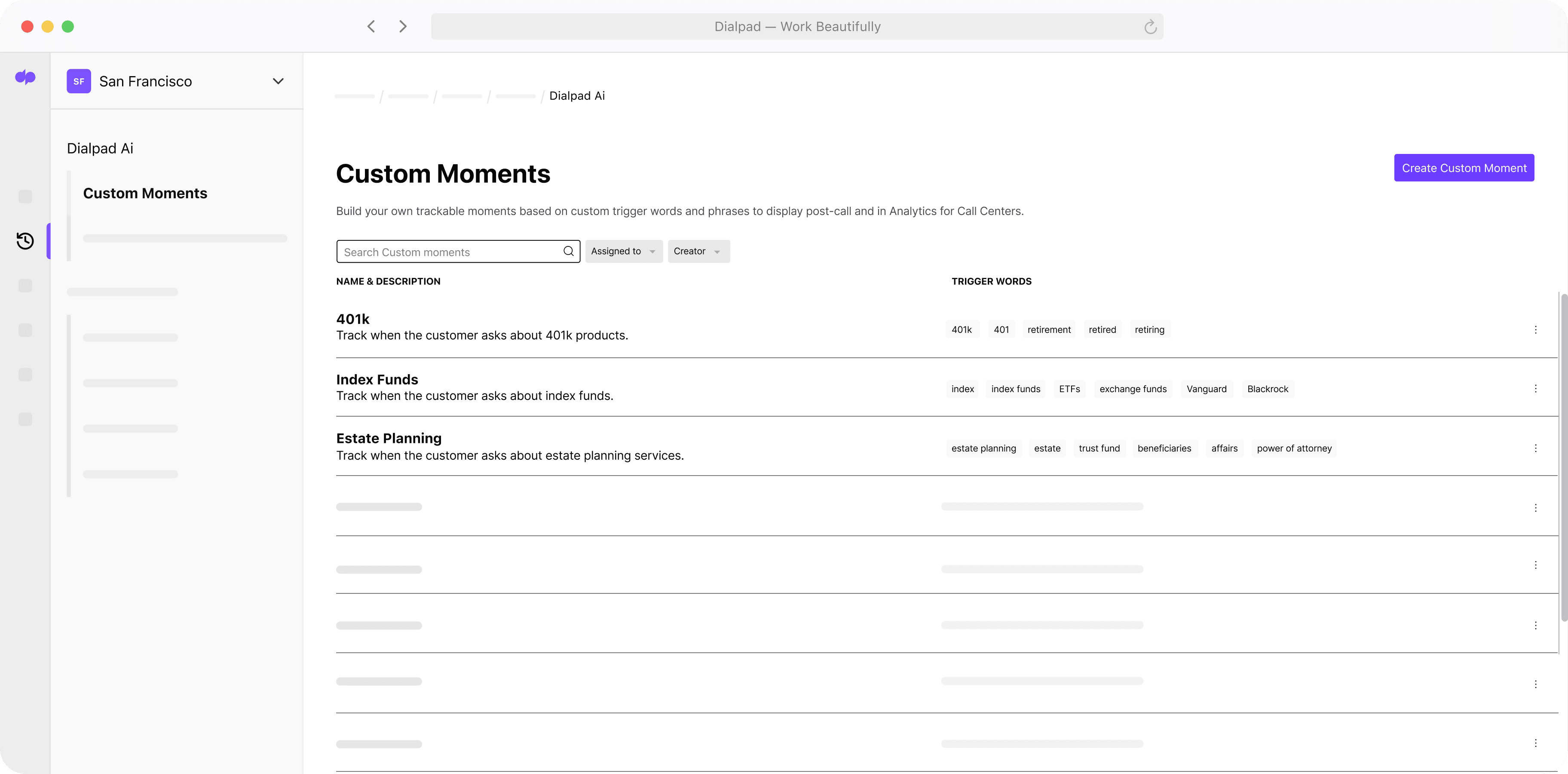
Another useful sales coaching feature in Dialpad is the playlist feature. Say your sales rep needs examples of what not to do on a call. You can take recordings of these sales calls, create a playlist, and share them with that rep so they can listen and learn on their own time.
👉 Side note:
Good sales coaching is important because it improves team performance and win rates (which most people tend to focus on), but there’s one more benefit here. By empowering your sales reps and giving them what they need to succeed, you’re ultimately increasing retention as well.
Coaching actions / behaviors
Beyond the calls themselves, you can also coach actions and behaviors.
When you coach actions and behaviors, your goal is to improve habits, techniques, and performance overall. Here, the goal is to help your salespeople build good, consistent habits. Not everyone comes into a sales organization with the same sales experience. Many are new to sales, and haven’t had the time or opportunities to build those good follow-up habits that are essential to sales success.
The problem is that often sales managers just don’t have the time or bandwidth to review sales calls for coaching opportunities. This is where we use Dialpad's Ai Scorecards, since it can review the calls for whether sellers did everything listed on the scorecard criteria.
It's pretty simple—sales managers and admins can easily create a QA Scorecard from their online dashboard, and as sales reps are having conversations with prospects, Dialpad Ai listens to each interaction and automatically suggests when the scorecard behavior is met.
Say you've added “Rep asked the prospect who the decision-makers are" to scorecard criteria. If the agent asks about decision-makers, whoever grades that call will immediately see that the activity was completed:
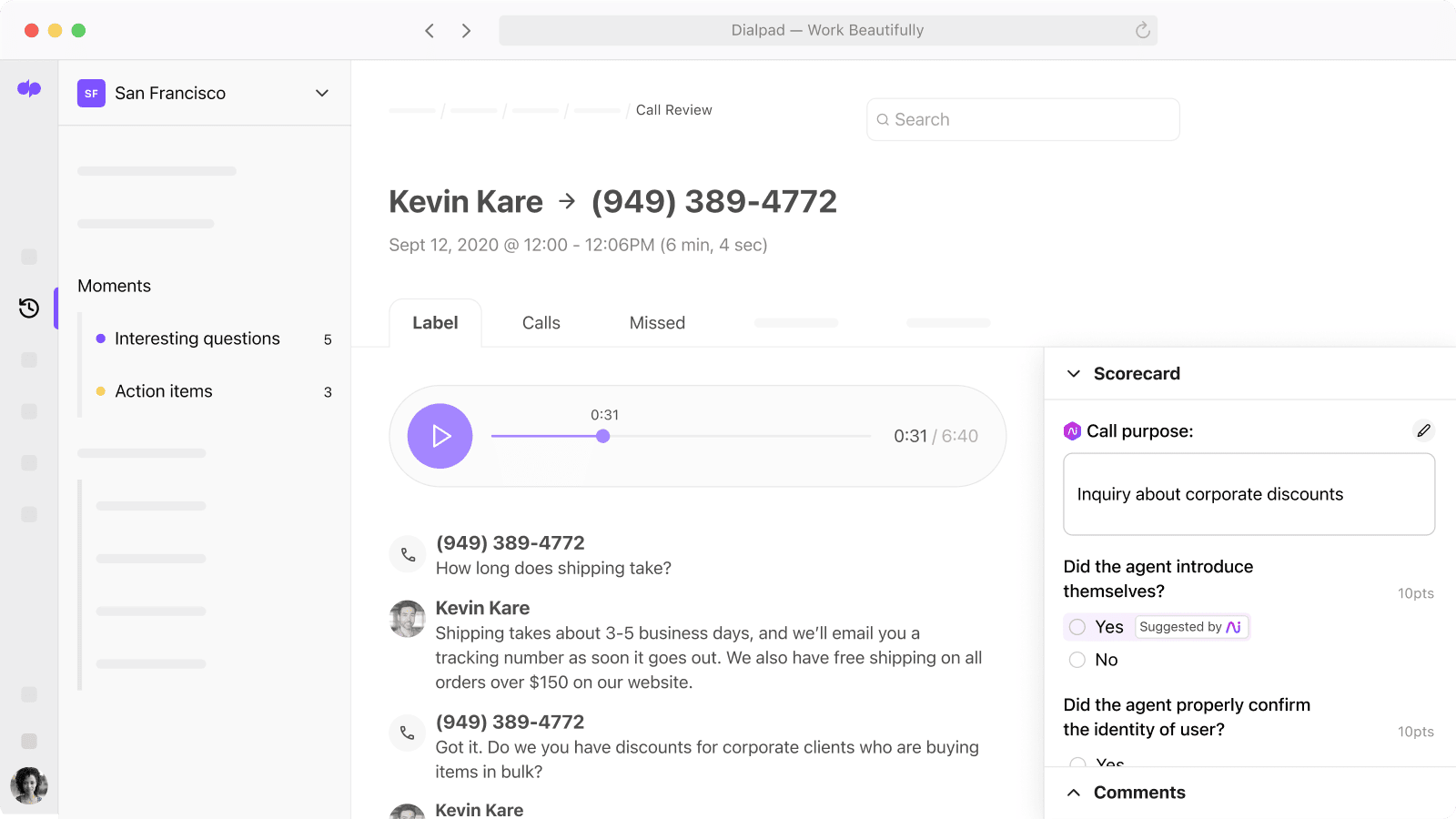
This makes it a lot easier for managers to see if there are certain actions or behaviors that sellers need to do more consistently—without us having to listen to the entire call recording or read the transcript.
Another thing we like doing in Dialpad is setting up “coaching teams” by partnering newer reps with seasoned sales reps. You can have multiple trainers in a coaching team too (so a rep can have their manager and their mentor as trainers).
Of course, you don’t have to pair a sales manager with the mentee—even a more seasoned sales rep would be a great mentor (especially because some managers or leaders may be running deals but not in the trenches as much anymore compared to someone who’s selling every day).
We can also leave feedback directly in transcripts for our sellers to review, which is another great feature that we use a lot.
👉 Dialpad tip:
Use metrics to coach the behaviors you want. For example, you might have your sales reps call 50 people a day and that’s the metric they have to hit to get up to speed and have the most “at-bats” or opportunities to speak with prospects.
Deal coaching
This isn’t so much about sales calls but more about timelining and running through deals. For example, what do you need to check off in order to make sure that deal is valid and worth your reps’ time? How should they negotiate and figure out who the key stakeholders are?
Coaching a sales team: Getting the best out of “Greener” and more tenured reps
One mistake that some leaders make is using the same sales coaching process for everyone.
Salespeople all have different experience levels and skillsets, and respond to different incentives. I could go in detail here in a whole separate blog post, but for now, we’ll look at sales coaching—specifically how to coach greener versus more tenured reps.
Let’s look at what great coaching might look like for these two types of salespeople and the differences to consider in your approach.
Coaching greener reps
1. Build their foundation
Not every new sales professional in your company arrives with the same experience. They may not know how to get the coaching they need out of you.
With greener sales reps, it’s important to focus on helping them build their foundation—not only in terms of the basics of sales (for those who’ve never had a sales job before), but also the basics of your products or services.
Depending on how complex or simple your product is, this will take a different amount of time and coaching.
At this point, your sales reps should understand that their first call with someone sets the stage for how the deal will go. For me, I’d look at whether they understand the product we’re selling, the process they need to follow to get this across the line, the words to say and how to respond in certain situations.
2. Give them shadowing opportunities
One of the most important things for new reps is to give them opportunities to learn from their more experienced teammates.
One good way to do this is to set up time each day for new team members to shadow more experienced reps and understand your sales process really well before they jump in and do it themselves.
With Dialpad, even with many folks in the sales organization working remotely, this is easy to do. For example, there’s a screen sharing feature and reps can listen in on mute so they can see firsthand what sales success looks like.
📚 Further reading:
Get more remote sales coaching tips.
3. Have a variety of resources prepared
For greener reps, absorbing as much knowledge as they can is essential. The good news is most of them understand this and are eager to soak up that knowledge.
As a sales manager or sales enablement leader, this means providing sales scripts, role plays—anything you can do to get reps up to the level of sales readiness you want to see.
Coaching more tenured reps
1. Go one level deeper
Your experienced sellers will (or should) already understand sales strategy and have their own action plans for quota attainment.
They know how sales processes should go and what needs to be checked off the list for something to be a valid deal.
For a software company like Dialpad, at this point the focus leans more toward the nuances of the product and our go-to-market process—for example, helping them understand the specifics of, say, why our product is better than a competitor beyond price and other basic factors.
2. Find creative ways to teach them new things
There are so many sales methodologies out there. It seems like a new methodology pops up every five years, and your more tenured sellers will have seen many of these come and go.
Because of this, you have to make it worth it for them to change or update behaviors that they’ve been doing for years and have found success doing.
It’s an interesting challenge—these reps are usually easier to coach because they’re experienced and if they’ve made it this long, they’re smart enough to know when to pivot. The difficult part is convincing them that it’s worth it to make those changes, and that it’ll actually bring them sales success (compared with green reps, who want to be a sponge and learn everything).
3. Give them the content they need
On a related note, because these reps have more experience, they really just need the things that will help them execute their action plan and support their GTM motions.
Instead of fancy new initiatives, often our more experienced reps will have very straightforward requests for content that they need.
Again, your goal is to facilitate. Do they need to be connected with your Marketing or Design team so they can make those requests for content directly? Maybe they would benefit from meeting with your Product or Product Marketing team to always be up to date on the latest features and what’s come down the pipe.
3 more things to consider to improve sales coaching effectiveness
Tools for online sales coaching
With the rise of hybrid work and work from anywhere models, remote sales team management is becoming more and more of a necessity.
When your reps can’t just sit next to more experienced team members anymore, how can they still shadow them and learn? How can you as a sales leader monitor metrics, review sales calls, and provide valuable insights to your team?
I’ll go more into tools for this below.
Regular metrics reviews
Every good sales coaching plan needs to be based on data—call times, customer sentiment, quota attainment, deals closed—this is important information to use in your coaching sessions. When you can see specifics, you can address them head-on instead of just guessing at what’s causing the problem.
For example, if you know that a rep has way more closed lost deals compared to their team members and you want to have a discussion with them, it helps to have data to back that up instead of just saying, “Hey I think you’re tagging too many deals as closed lost.”
Your most important behaviors
To hit quota attainment, the best way to coach your sellers—especially the newer reps—is to focus on coaching behaviors.
I mentioned this earlier, but I can’t overstate the importance of this. Every sales representative has a different style, personality, and skills. The simplest way to get every team member on the same page and hitting requirements quickly is to coach behaviors.
This way, you don’t get caught up in nitpicking on things like how they speak or words they use—they can still be important, don’t get me wrong, but they’re not necessarily the first thing you should prioritize in a coaching plan.
If you can make sure that your sellers are all, say, making 50 or 75 outbound calls and sending 100 prospecting emails a day, that’s not only easier to measure, it also gives you more data and insights to coach against.
📚 Further reading:
AI is one of the biggest tools that we use to keep our sales team performing at a high level consistently. Learn more about AI in sales coaching.
7 sales coaching software options to enhance your program
For any sales coaching or sales enablement program, having the right tools is essential. I’ll walk through three main types of software that almost all sales teams will need.
Category A: Overall sales communications
Your all-in-one, go-to tool you use every day. An overall sales communication app is a critical component of your workflow, and you can’t imagine living without it.
1. Dialpad
Any sales team needs a communications platform. Whether you’re doing high volume outreach or not, your sales reps need something to communicate with prospects, and ultimately, close deals with.
With Dialpad, we can make phone calls, have video meetings, send SMS/MMS text messages, and more—all from a single desktop or mobile app. Actually, prospects don’t even have to download the app to join a conference call or video meeting. They can just click the meeting link and join from their web browser. Many of our own prospects and clients love this because they usually don’t want to have to download software:
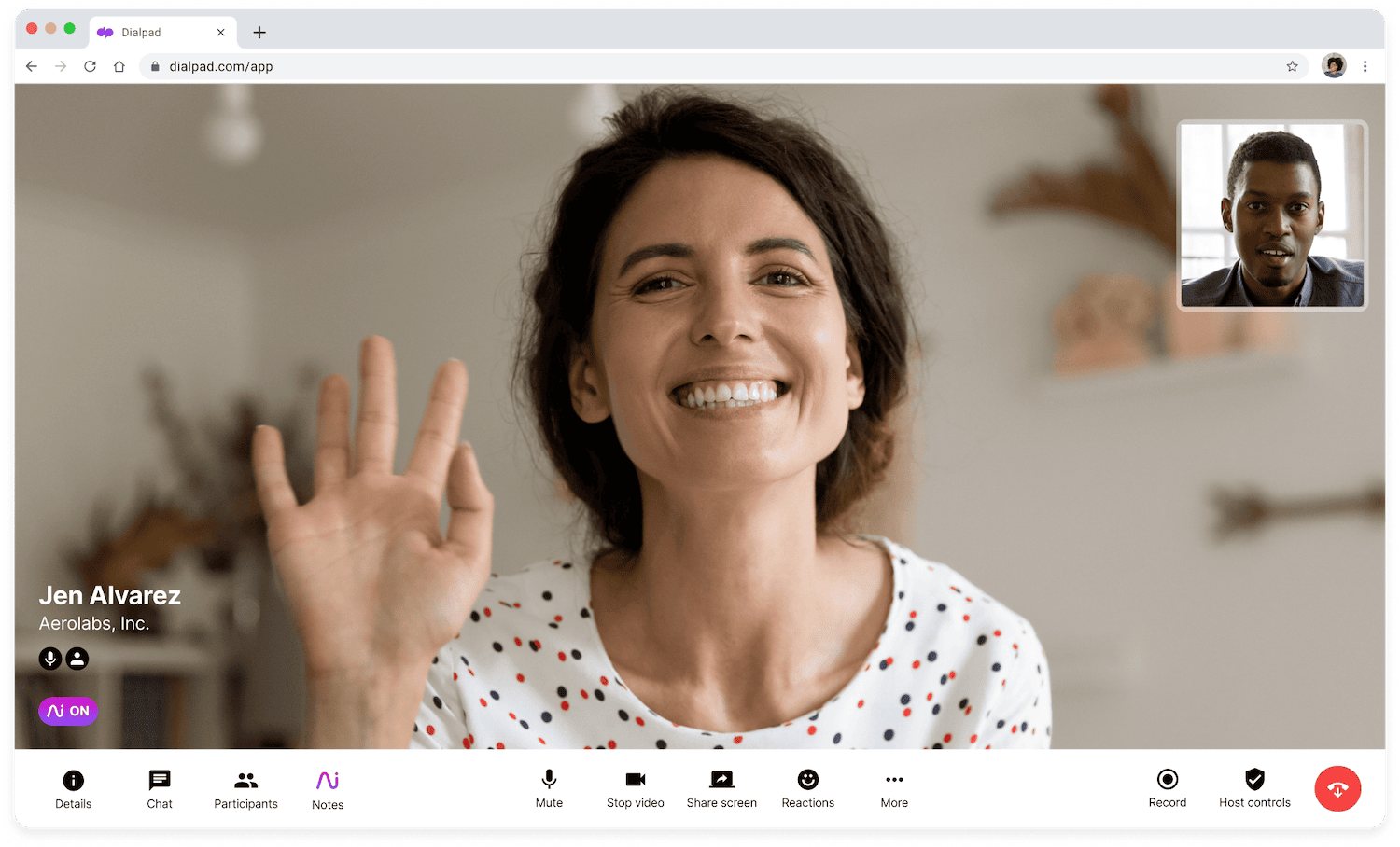
And one thing our own sales team likes is that they can even invite someone to a screen share by sending them an SMS message with a link. Again, prospects don’t have to download anything to join the screen share, which they tend to like.
I mentioned Custom Moments and RTA cards earlier, which are helpful for tracking keywords and automating sales coaching, but beyond this AI-powered functionality, Dialpad also integrates with quite a few sales tools.
The next section is about CRMs, so I won’t mention them here, but if your sales organization is using Outreach, Dialpad integrates with that as well:
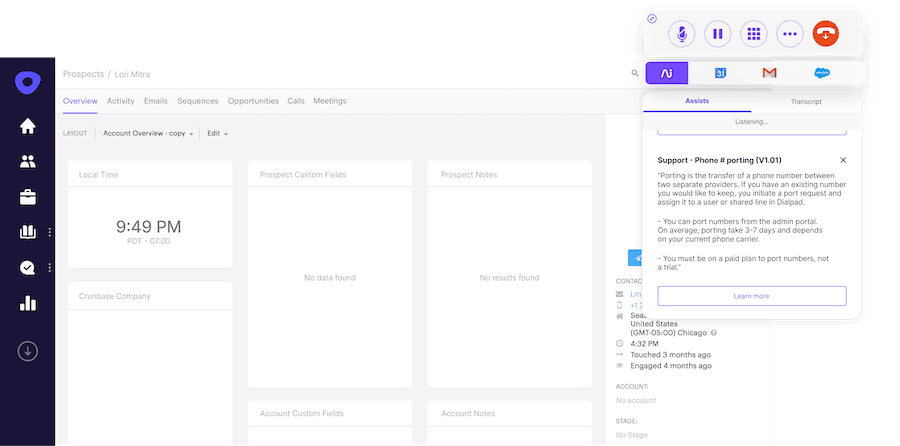
A few other features that come included with Dialpad:
Voicemail drop: Something that’s especially useful for high volume outbound sales teams. Instead of having to recite a message every time they hit a prospect’s voicemail greeting, a rep can “drop” in a pre-recorded message with a click. What used to take a few minutes now takes a second or two. It may not sound like a lot, but for reps who make a ton of calls every day, this can really add up and give them a lot of time back to focus on other more high-value tasks.
Apps that work across different devices: Dialpad’s app works on iOS, Android, PC, and Mac devices. No matter what computers or cell phones your reps are using, Dialpad will work on them.
Call monitoring features like barge, whisper, and listen-in
AI-powered features like real-time voice transcription, RTA cards, speech coaching, and more:
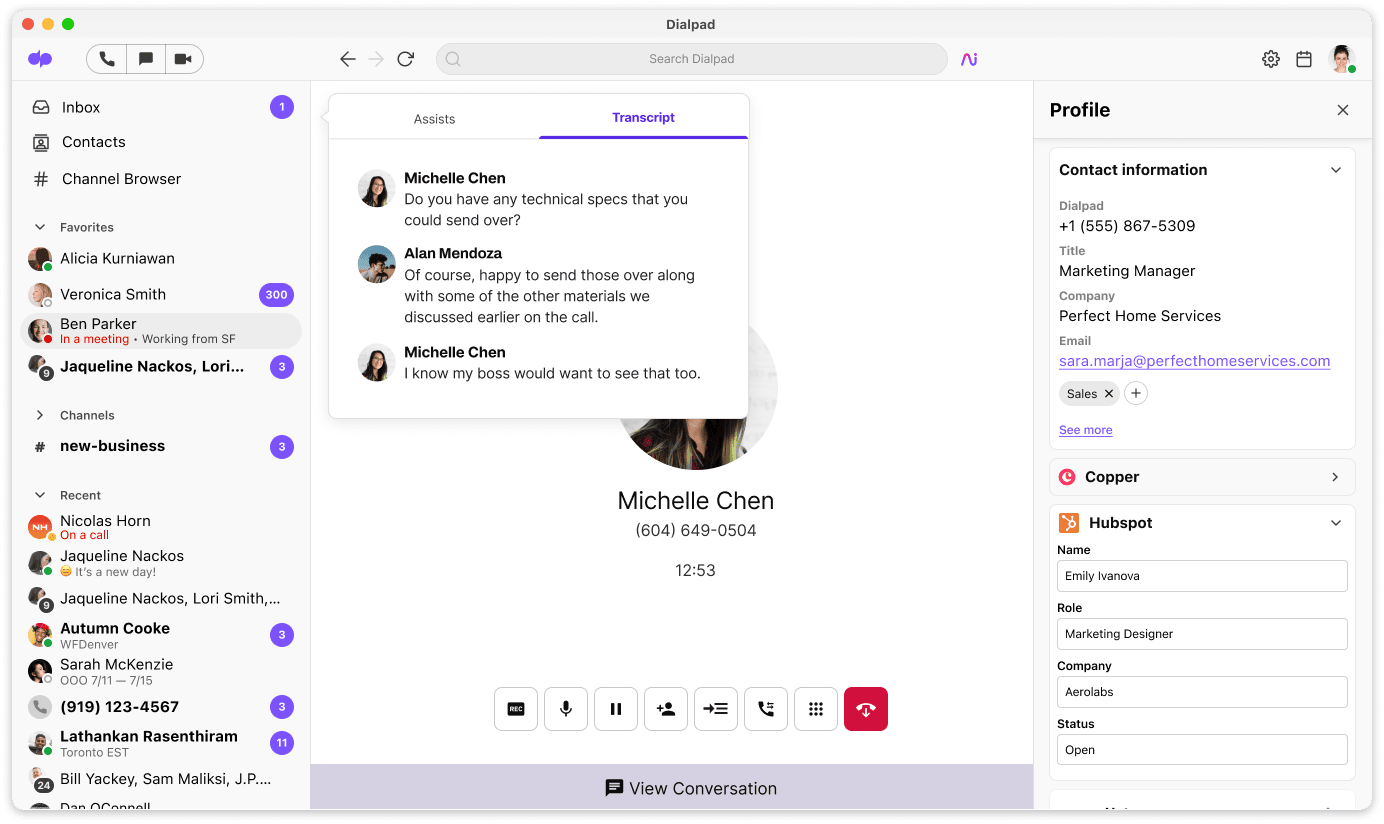
Category B: CRM
No sales team is complete without a CRM in their tech stack. It’s a must-have for organizing data like customer details and relationship history—and more importantly, it can integrate with your business phone system or cloud contact center platform to help reps save serious time.
2. Salesforce
This one probably doesn’t need an introduction. Salesforce is one of the most commonly used CRMs around, letting sales teams view customer details, previous communications and interactions, activity history, and more. You can see all of your team’s deals in one location and know where every deal is in the sales cycle.
More importantly, Salesforce integrates with Dialpad. What that means: Sellers can make phone calls from the Dialpad dialer right inside Salesforce without having to switch to another window. And not only does the integration automatically log calls and activities in Salesforce, the AI coaching features I mentioned earlier, like the real-time transcriptions and RTA cards, are also available inside Salesforce:
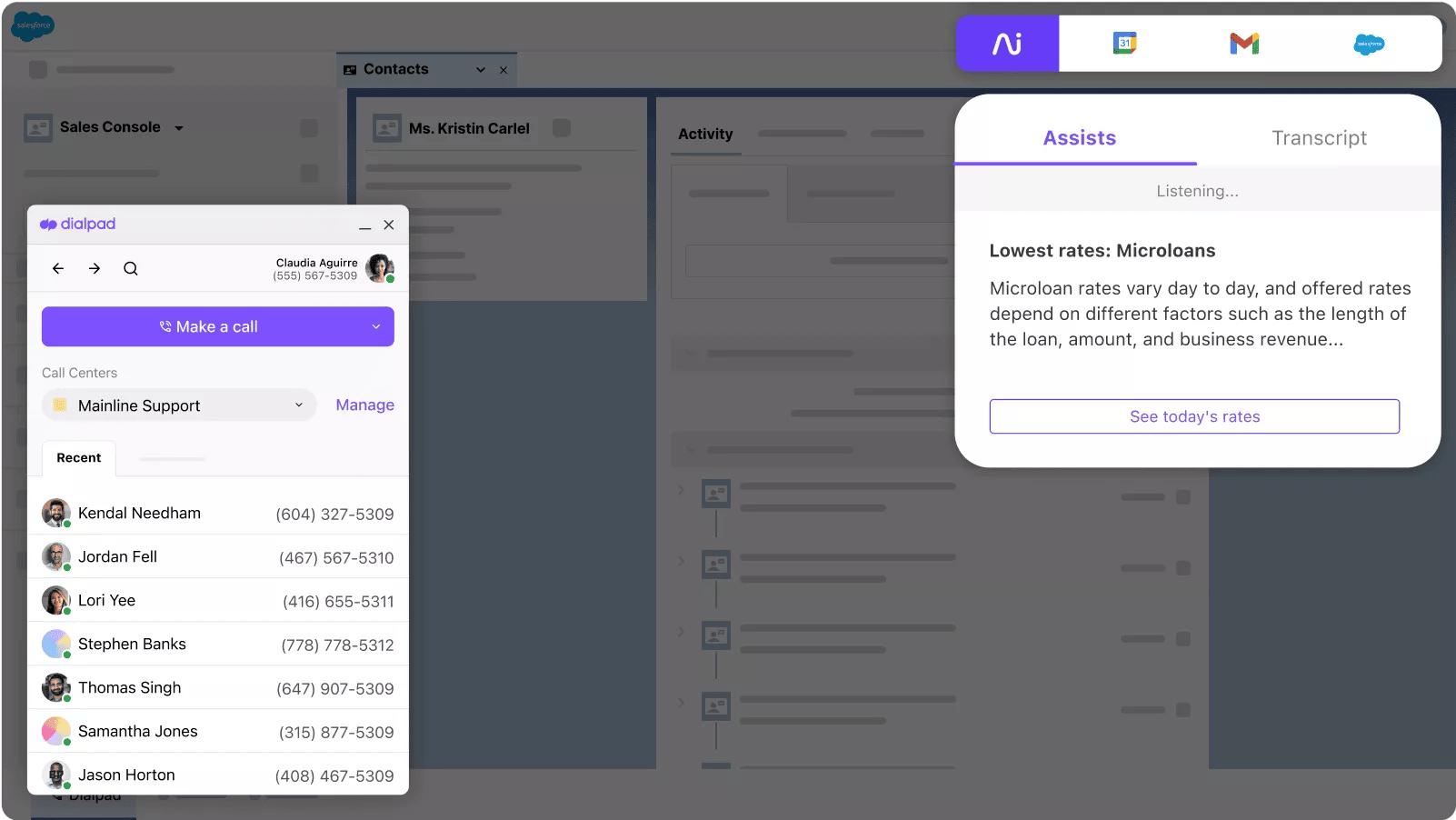
That means sales reps can stay in Salesforce, communicate with prospects, and do all their work from one place. And best of all, the integration works just as well in the mobile app as it does in desktop. (Most Salesforce integrations work fine on desktop, but don’t work at all, or are very clunky on mobile.)
3. HubSpot
HubSpot is another CRM that’s popular with small businesses. Like with Salesforce, it lets reps and sales leaders manage customer relationships and deals in one place.
HubSpot also has a big library of integrations, for example, with Dialpad, which lets you log calls and create contacts. And it also embeds Dialpad’s CTI dialer inside the CRM so that reps can, again, handle calls from right inside HubSpot:

4. Zoho CRM
Lastly, Zoho CRM is part of the Zoho suite (similar to how HubSpot has a product suite) to house all your customer and prospect information, activity logs, and so on.
Similar to the other CRMs above, it integrates with Dialpad (you’ve probably noticed by now that Dialpad has a lot of sales-friendly integrations with CRMs) to automate repetitive low-value tasks for sellers (like data entry and activity logging):
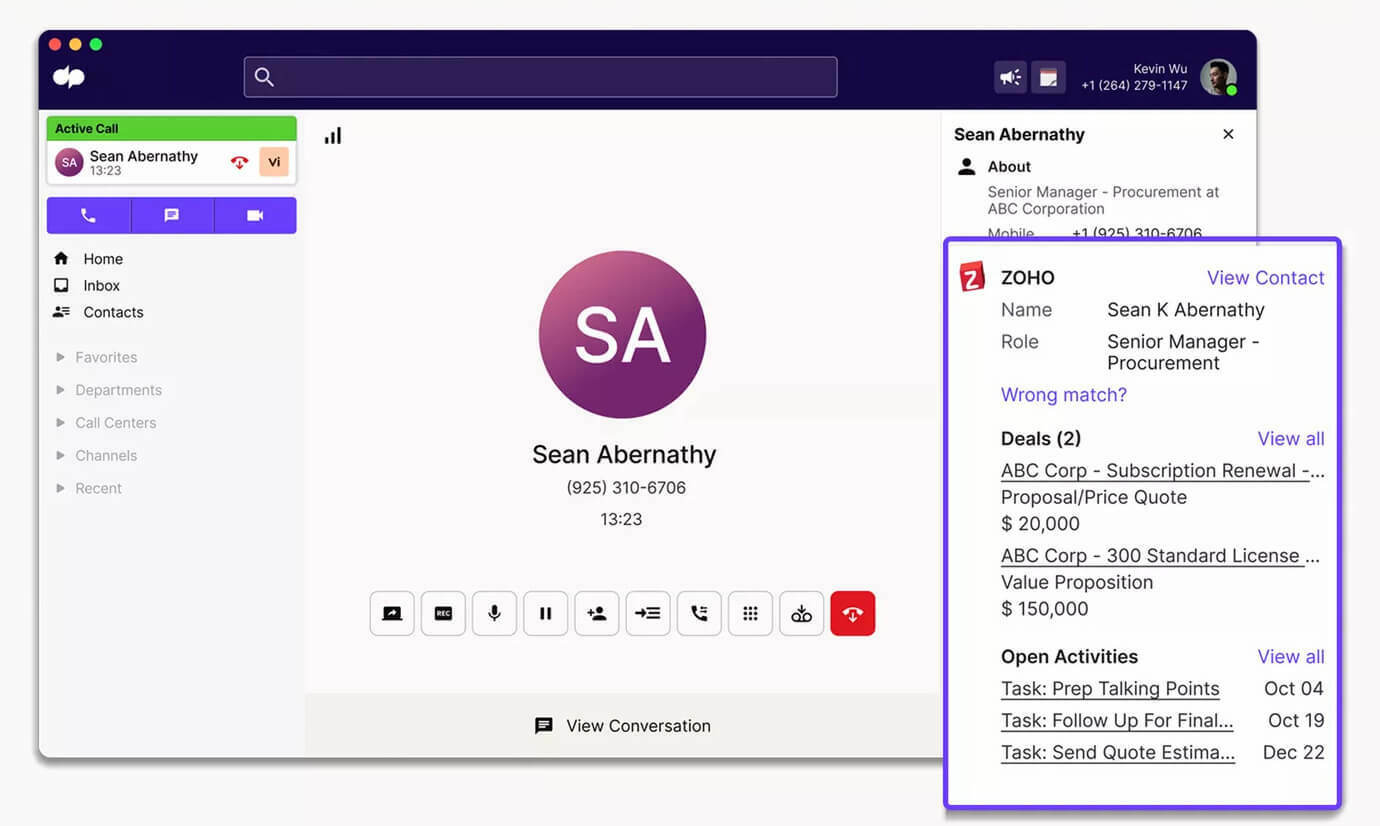
Category C: Sales content management
Giving your sellers the content they need is one big must-have for sales enablement.
Whether these are whitepapers, spec sheets, customer stories, or even video, there’s a wide range of content that you could equip your sales team with.
It used to be that sales orgs would just keep all these files in Google Drive or some shared folder—but there’s a better way to do it. Storing content is one thing. The real question is how can you organize this content so that it actually supports your sales coaching activities?
For example, if you have sales reps who are in a certain territory or selling to a specific industry, how can they easily find sales enablement content for that territory or industry? (If they’re selling to healthcare practices, for instance, it would be helpful if they could filter the content so that only healthcare-related sales enablement content comes up.)
Here are some of the best sales enablement tools I’ve seen.6. Highspot
With Highspot, you can easily create a powerful sales library that sellers can search to find the content they need.
You can even create sales playbooks for important target customers or industries that sales reps can use to run specific deals.
7. Showpad
Showpad is similar to Highspot—it also allows you to sync an existing library of content from another service with its own library, automatically organizing everything into one, manageable system.
One neat thing about Showpad is that when you add something new or remove old content, your team will be notified automatically, which keeps everyone in the loop. Showpad can also recommend content on your homepage based on the deals you’re currently working on.
Sales coaching and training: Key components to driving sales performance
The benefits of sales coaching are far-reaching and, if done, correctly, can sustain a sales organization over the long term.
Bottom line: Improving sales performance isn’t just about teaching sellers about your product and giving SPIFs and other incentives. You have to give them the right technology, especially if you have a distributed sales team, and a sales coaching strategy that is tailored to reps’ different skill sets and experience levels.
Set your sellers up for success
If your sales org needs a better contact center or communications platform to call and meet with prospects, book a demo of Dialpad—or take a self-guided interactive tour of the app on your own!

